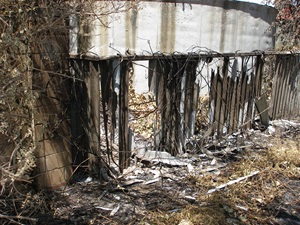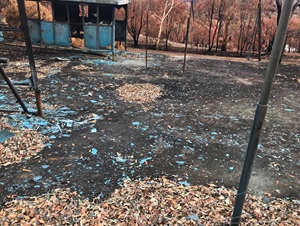Fire damaged asbestos
- Do not enter a property that contains burnt or fire damaged asbestos
- Asbestos is a cancer and lung disease hazard.
- If in doubt, treat suspicious materials as asbestos.
- Contact a licensed asbestos removalist for removal of fire damaged asbestos.
There may be damaged asbestos on a property following a fire. This will most often be asbestos cement sheeting (fences, walls, roofs, eaves).
If in doubt, treat flat or corrugated cement sheeting from buildings built prior to 1990, as asbestos until confirmed otherwise. Other building products may contain asbestos. Read more on asbestos used in Western Australian homes.
Burnt asbestos containing products are more likely to release airborne asbestos fibres. Avoid breathing in asbestos fibres by taking safety precautions that prevent dust and fibres being disturbed.
What happens to asbestos during a fire
During a fire, asbestos cement sheets often shatter from the heat and the flakes, fragments or clumps of asbestos cement can be spread around and mix with other fire debris.
If damaged asbestos material is disturbed in a way that creates dust, asbestos fibres can be released and inhaled into the lungs.
That is why it is important that people are restricted from entering any area with fire debris. Removal and clean-up need to be completed by a trained and licenced asbestos removalist who will use the necessary precautions to protect you and your family’s health.


Neighbouring properties and public areas
Anyone impacted by smoke from a fire should close all external doors and windows and stay indoors.
It is possible that fire debris, including shattered pieces or flakes of asbestos cement material is found on adjoining properties close to the fire. Emergency services or local government officers may barricade impacted areas including surrounding properties, pathways or roads.
Immediate actions taken after a fire
Following a fire, emergency services and local government environmental health services may take immediate measures to prevent disturbance of asbestos contamination. Actions may include:
- erecting temporary fencing or barrier tape to prevent people from accessing affected areas (if possible)
- installing asbestos warning signs to inform people of the asbestos hazard
- removal of asbestos containing debris from public access ways and roads to prevent spread and minimise exposure
- keeping the affected area damp by using a fine mist water spray or a mixture of PVA glue or bonding agent to stop dust and airborne fibres (a dye is often added to easily see which areas have been treated).
These controls need to remain in place and be monitored until removal work can be completed.


Entering the property – protect yourself and your family
Initially, access to the property should be limited to emergency services and other professionals involved in the property assessment and clean-up. They are required to follow strict safety precautions.
Only enter a property if emergency services say it is okay to do so. Children should not be allowed to enter a property with fire damaged asbestos or where other hazards are present.
If a property owner or anyone else decides to enter the property, such as to recover or secure personal items or look after livestock, they should take precautions, including wearing personal protective equipment and avoid disturbing any material that may contain asbestos. Be aware of all other hazards.
Before entering the property, make sure you read:
Removal and clean-up of asbestos on your property
The responsibility for arranging assessment and clean-up of asbestos contamination in smaller property fires falls to the property owner. The owner can hire a licensed asbestos removalist who knows how to safely remove and dispose of asbestos, then decontaminate the property to minimise health risks.
If you are the property owner, you should call your insurance company as soon as possible to make arrangements for removal and clean up.
If you are not insured, you will need to arrange and pay for removal, clean-up and obtain a clearance certificate. A clearance certificate is provided by a qualified person, independent from the removal contractor, who assesses the adequacy of the removal work. You will need to hire:
- a Class A licensed asbestos removalist for the removal work, and
- a licensed asbestos assessor to complete a clearance certificate.
In some cases, where damage is not extensive, you may be able to use a Class B licensed contractor for the removal and an independent competent person to complete a clearance certificate.
You can search for licensed asbestos removalist and asbestos assessors (external site) operating in WA. Contact WorkSafe (external site) if you have any questions regarding licensing requirements.
If you are renting, you should discuss your situation with your property manager or the house owner as soon as possible.
More information on professional removal, licence requirements and clearance certificates is available from asbestos removal and licensing (external site).
Where to get help
If a fire occurs at a residential house, the Local Government Environmental Health Officer should be advised and they can assist you with what needs to be done. They also can confirm the removal and clean-up is correctly managed.
If a property is burned during a large bushfire event that results in significant costs to communities, the Western Australian Disaster Recovery Funding Arrangements (external site) may take charge of some or all of the removal and clean-up and work with emergency and response agencies, and the Local Government Environmental Health Officer to manage risks.
Last reviewed: 14-12-2023
This publication is provided for education and information purposes only. It is not a substitute for professional advice. Information about a service, product or treatment does not imply endorsement and is not intended to replace professional advice. Readers should note that over time currency and completeness of the information may change. All users should seek advice from a qualified professional for answers to their questions.